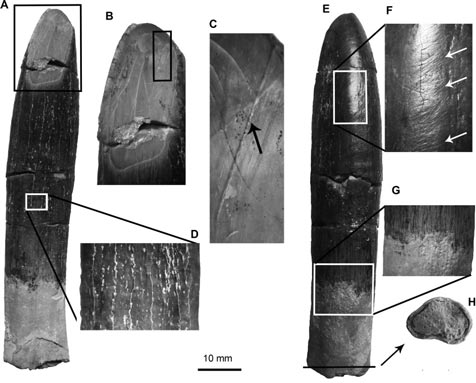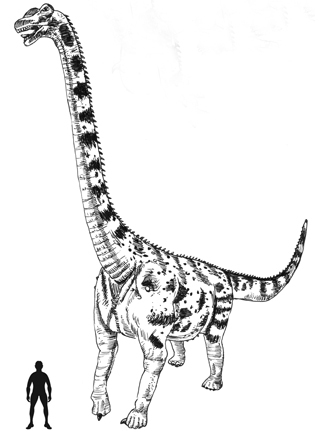Single Giant Tooth Tantalises Scientists with Prospect of “Enormosaurus“
A distinguished palaeontologist from the National University of Rio Negro in Argentina has published a scientific paper on the discovery of a single tooth, a fossil which may have serious implications on the estimated size of the largest land animals known to science.
Huge Titanosaur Tooth
Rodolfo Garcia, a specialist in the study of South American dinosaurs that lived during the Cretaceous geological period, writing in the academic journal “Cretaceous Research” states that a tooth found in strata of the Allen Formation at Salitral de Santa Rosa, Rio Negro (Argentina) is thirty-two percent bigger than any other tooth from the same type of dinosaur found to date. The tooth is believed to have belonged to a titanosaur, a plant-eating, long-necked type of dinosaur. The chisel shaped tooth measures in excess of seven and a half centimetres in length (including the crown and the root), this is nearly as third as big again as the largest titanosaur tooth previously known.
The Super-sized Tooth of Perhaps a Super-sized Titanosaur?
Picture credit: National University of Rio Negro/Journal of Cretaceous Research
Note the scale bar in the picture.
The Titanosaurids
The titanosaurids were the last group of sauropods (long-necked dinosaurs examples of which include the Jurassic Diplodocus and Brachiosaurus), to evolve. The exact taxonomic relationship between the titanosaurs of the Late Jurassic and the Cretaceous and the earlier Jurassic Sauropoda remains unclear. The titanosaurids are the only type of sauropod to have survived until the very end of the Age of Dinosaurs (sixty-five million years ago). Fossils of these animals have been found in the Americas, Africa, Europe, Australia, New Zealand, India and Asia.
The lack of titanosaur fossils from Antarctica was thought due to the lack of sampling and not a reason to exclude this fauna from that part of the super-continent of Gondwanaland that we now know as Antarctica. In 2011, a single fragmentary vertebrae discovered in Antarctica did indeed, suggest that these large, herbivores had roamed all off the southern continents in the Late Cretaceous.
A number of titanosaurs were believed to have been armoured, perhaps an adaptation to the evolution of large, super-predators such as the abelisaurids and the tyrannosaurs. Several genera of titanosaur can lay claim to the title of the largest, land living creatures known to science. Paralititan from North Africa may have measured in excess of thirty metres, Andesaurus, fossils of which have been found in Argentina may have been bigger still and a recent discovery of cervical vertebrae in the southern United States suggests that Alamosaurus may have reached lengths well in excess of thirty metres too.
The dinosaur regarded as the largest of the titanosaurs at the moment is the colossal Argentinosaurus huinculensis, which as the name suggests was also discovered in Argentina (western Argentina, Huincul). It may have measured more than thirty-five metres in length and weighed as much as one hundred tonnes.
A Scale Drawing of Argentinosaurus (A. huinculensis)
Picture credit: Everything Dinosaur
The picture (above) shows a scale drawing of Argentinosaurus. The drawing is base on the CollectA Argentinosaurus figure. To view this range: CollectA Dinosaur Figures (Age of Dinosaurs Popular).
The trouble is, most large titanosaurs are only known from a few fragmentary fossils. Their true size can only be estimated based on the scant fossil evidence palaeontologists have to study. The finding of an enormous tooth in strata from the Allen formation (fossil reference: MML-Pv 1030), leads to the intriguing prospect of even bigger dinosaurs awaiting discovery.
The tooth, the biggest titanosaur tooth to be described comes from Upper Cretaceous aged strata (mid Campanian to lower Maastrichtian faunal stage), it has been tentatively dated to around 77 to 73 million years ago. The single tooth is thirty-two percent larger than the previously largest titanosaur tooth described. The former record holder came from a titanosaur genus known as Nemegtosaurus whose fossils have been found in the famous Nemegt Formation of Mongolia. Like many titanosaurs Nemegtosaurus is poorly known with one single incomplete specimen including a partial skull for the scientists to study. The teeth of this Late Cretaceous titanosaur were chisel-like, large and limited to the very front of the jaws.
For Rodolfo Garcia, the discovery of this single, shed tooth may mean that there is another genus of titanosaur awaiting discovery in the Allen Formation, one that will become known as the biggest terrestrial animal known in the fossil record. Perhaps, the dinosaur who lost this tooth was not that big but had unusually large teeth for its size, or indeed the tooth could actually turn out to belong to an already described, but poorly known genus of South American titanosaur.
The wear and tiny scratches on the tooth are being studied by the research team as they hope to infer feeding behaviour and dietary information from this fossil find.
If a new genus is erected based on this single specimen, this would not be the first time that this has happened in the study of the Dinosauria. In 1825, when Gideon Mantell described Iguanodon he did so largely based on the finding of teeth that reminded him of the teeth of extant iguana lizard. The marine reptile Liopleurodon was established as a genus after the describing of some large teeth found in France, it does not take much to erect a new genus. However, there is one little “fly in the ointment” when it comes to trying to estimate the size of dinosaurs. It seems that unlike mammals, dinosaurs grew a little bit each year as long as they lived – what scientists term indeterminate growth. A very old Argentinosaurus for example, would grow a little bit more each year it lived. It would not have the rapid growth or growth spurts that occurred when it was young, but even a one percent increase in size each year for a dinosaur already in excess of thirty metres long would add another foot or so to its overall length.
At the moment this single tooth raises the possibility that scientists may have to come up with another superlative to appropriately describe a new, huge genus of long-necked dinosaur. The likes of Supersaurus and Seismosaurus have already been used, so how about “Enormosaurus” being established to describe the genus of titanosaur associated with this enormous tooth.







Leave A Comment